Sunday, October 11th 2015

ASUS ROG Maximus VIII Impact Mini-ITX Motherboard Now Available
ASUS Republic of Gamers (ROG) today announced Maximus VIII Impact, a mini-ITX motherboard with ATX-grade performance for enthusiast gamers, and engineered and tested for the best compatibility with both mini-ITX case designs and CPU coolers - giving users the confidence to build small to game big.
Based on the new Intel Z170 Express chipset and LGA 1151 socket for the latest 6th-generation Intel processors, Maximus VIII Impact offers extreme performance and overclocking features in mini-ITX, with the vertically-mounted Impact Power III full-scale voltage-regulator module (VRM), 5-Way Optimization and bundled Fan Extension Card for easy tuning and cooling, Pro Clock technology to push base-clock frequencies beyond the limits, and compatibility with the latest DDR4 memory modules - for extreme overclocked-RAM speeds of 4133 MHz and higher.Maximus VIII Impact also offers the best mini-ITX audio in the shape of SupremeFX Impact III, and the best lag-banishing networking technologies with Intel Gigabit Ethernet, plus ASUS LANGuard and GameFirst technologies to prioritize game traffic and minimize ping times.
For the best mini-ITX connectivity, Maximus VIII Impact boasts all-new Multi-User MIMO (MU-MIMO) for maximum speed to every connection, along with U.2 and USB 3.1 for lightning-speed transfers.
Best mini-ITX performance: Impact Power III, 5-Way Optimization, Pro Clock and 4133 MHz DDR4
Impact Power III is Maximus VIII Impact's completely-digital power architecture, engineered with premium components to provide precise power management and stable overclocking on mini-ITX. Dynamic speed adjustments and intricate manual controls enable the user to push the processor and memory further than ever - and that means the highest stability and precision.
Maximus VIII Impact also has exclusive 5-Way Optimization that sorts all the complex settings with a click, for instant, highly-controllable performance boosts. This exclusive technology dynamically optimizes essential aspects of Maximus VIII Impact-based builds by monitoring real-time use, delivering superb CPU performance, everyday energy savings, ultra-stable digital power, cool and quiet fans and even networking and audio settings that are tailored for the apps currently in use.
Pro Clock technology is an ASUS-exclusive dedicated base-clock (BCLK) generator designed for 6th-generation Intel processors. It allows Maximus VIII Impact users to overclock base-clock frequencies to 400 MHz, or even beyond. This custom solution works in tandem with the ASUS-exclusive TurboV Processing Unit (TPU) to enhance voltage and base-clock overclocking control. Boot times can be reduced, jitter is lowered and stability is increased under heavy overclocking - providing an exciting new way to boost performance to extreme heights.
Maximus VIII Impact users are also able to go faster by fitting the very latest DDR4 memory, and push for extreme overclocked-RAM speeds of 4133 MHz and higher.
Best mini-ITX audio: SupremeFX Impact III, illuminated audio jacks and 600ohm Sonic SenseAmp
SupremeFX Impact III represents the pinnacle of mini-ITX audio quality, featuring the best gaming-audio inputs and outputs, color-coded LEDs to guide to the right audio jacks, and a collection of carefully-selected professional-grade audio components, including an ESS ES9023P digital-to-analog converter (DAC) with Hyperstream technology, ultra-low-jitter clock, Nichicon capacitors, 2VRMS headphone amp, and Sonic SenseAmp that automatically detects and optimizes any headset between 32 and 600ohms for the purest sound quality.SupremeFX Impact III also features intuitive Sonic Studio II, making it easy for the listener to apply and enjoy different audio effects for perfect entertainment - plus Perfect Voice noise-cancellation technology for team conversations with total clarity.
Best mini-ITX networking: Intel Gigabit Ethernet, plus exclusive LANGuard and GameFirst
Maximus VIII Impact has the best lag-banishing networking technologies, including the latest Intel Gigabit Ethernet to reduce CPU overhead and deliver exceptionally-high TCP and UDP throughput - freeing up more computing power for gameplay.
ASUS-exclusive LANGuard's signal-coupling technology and premium surface-mounted components ensure reliable connections and better throughput.
New and improved GameFirst technology optimizes network traffic for faster, lag-free online gaming - and now we've added Multi-Gate Teaming, enabling Maximus VIII Impact users to team all their networks for maximum bandwidth and the smoothest-ever gameplay. It also includes all-new Intelligent mode, which automatically compiles a database by parsing new app data to ensure that every game is optimized for the best performance.
Best mini-ITX connectivity: 2x2 802.11ac MU-MIMO Wi-Fi, U.2 and USB 3.1
Maximus VIII Impact delivers next-level 802.11ac Wi-Fi with 2x2 dual-band 2.4/5GHz antennas for up 867 Mbps transfer speeds - and the very latest Multi-User MIMO (MU-MIMO) technology to ensure that every connected user experiences the best wireless and online speeds.
Maximus VIII Impact also lets users unlock the full potential of the latest NVM Express (NVMe) technology to make SSDs scream at top speed. The new mini-ITX motherboard's built-in U.2 connector serves up data-transfer speeds of up to 32Gbit/s, and the board includes both USB 3.1 Gen 2 Type-A and reversible Type-C connectors for data-transfer speeds of up to 10Gbit/s - that's twice as fast USB 3.0.
Based on the new Intel Z170 Express chipset and LGA 1151 socket for the latest 6th-generation Intel processors, Maximus VIII Impact offers extreme performance and overclocking features in mini-ITX, with the vertically-mounted Impact Power III full-scale voltage-regulator module (VRM), 5-Way Optimization and bundled Fan Extension Card for easy tuning and cooling, Pro Clock technology to push base-clock frequencies beyond the limits, and compatibility with the latest DDR4 memory modules - for extreme overclocked-RAM speeds of 4133 MHz and higher.Maximus VIII Impact also offers the best mini-ITX audio in the shape of SupremeFX Impact III, and the best lag-banishing networking technologies with Intel Gigabit Ethernet, plus ASUS LANGuard and GameFirst technologies to prioritize game traffic and minimize ping times.
For the best mini-ITX connectivity, Maximus VIII Impact boasts all-new Multi-User MIMO (MU-MIMO) for maximum speed to every connection, along with U.2 and USB 3.1 for lightning-speed transfers.
Best mini-ITX performance: Impact Power III, 5-Way Optimization, Pro Clock and 4133 MHz DDR4
Impact Power III is Maximus VIII Impact's completely-digital power architecture, engineered with premium components to provide precise power management and stable overclocking on mini-ITX. Dynamic speed adjustments and intricate manual controls enable the user to push the processor and memory further than ever - and that means the highest stability and precision.
Maximus VIII Impact also has exclusive 5-Way Optimization that sorts all the complex settings with a click, for instant, highly-controllable performance boosts. This exclusive technology dynamically optimizes essential aspects of Maximus VIII Impact-based builds by monitoring real-time use, delivering superb CPU performance, everyday energy savings, ultra-stable digital power, cool and quiet fans and even networking and audio settings that are tailored for the apps currently in use.
Pro Clock technology is an ASUS-exclusive dedicated base-clock (BCLK) generator designed for 6th-generation Intel processors. It allows Maximus VIII Impact users to overclock base-clock frequencies to 400 MHz, or even beyond. This custom solution works in tandem with the ASUS-exclusive TurboV Processing Unit (TPU) to enhance voltage and base-clock overclocking control. Boot times can be reduced, jitter is lowered and stability is increased under heavy overclocking - providing an exciting new way to boost performance to extreme heights.
Maximus VIII Impact users are also able to go faster by fitting the very latest DDR4 memory, and push for extreme overclocked-RAM speeds of 4133 MHz and higher.
Best mini-ITX audio: SupremeFX Impact III, illuminated audio jacks and 600ohm Sonic SenseAmp
SupremeFX Impact III represents the pinnacle of mini-ITX audio quality, featuring the best gaming-audio inputs and outputs, color-coded LEDs to guide to the right audio jacks, and a collection of carefully-selected professional-grade audio components, including an ESS ES9023P digital-to-analog converter (DAC) with Hyperstream technology, ultra-low-jitter clock, Nichicon capacitors, 2VRMS headphone amp, and Sonic SenseAmp that automatically detects and optimizes any headset between 32 and 600ohms for the purest sound quality.SupremeFX Impact III also features intuitive Sonic Studio II, making it easy for the listener to apply and enjoy different audio effects for perfect entertainment - plus Perfect Voice noise-cancellation technology for team conversations with total clarity.
Best mini-ITX networking: Intel Gigabit Ethernet, plus exclusive LANGuard and GameFirst
Maximus VIII Impact has the best lag-banishing networking technologies, including the latest Intel Gigabit Ethernet to reduce CPU overhead and deliver exceptionally-high TCP and UDP throughput - freeing up more computing power for gameplay.
ASUS-exclusive LANGuard's signal-coupling technology and premium surface-mounted components ensure reliable connections and better throughput.
New and improved GameFirst technology optimizes network traffic for faster, lag-free online gaming - and now we've added Multi-Gate Teaming, enabling Maximus VIII Impact users to team all their networks for maximum bandwidth and the smoothest-ever gameplay. It also includes all-new Intelligent mode, which automatically compiles a database by parsing new app data to ensure that every game is optimized for the best performance.
Best mini-ITX connectivity: 2x2 802.11ac MU-MIMO Wi-Fi, U.2 and USB 3.1
Maximus VIII Impact delivers next-level 802.11ac Wi-Fi with 2x2 dual-band 2.4/5GHz antennas for up 867 Mbps transfer speeds - and the very latest Multi-User MIMO (MU-MIMO) technology to ensure that every connected user experiences the best wireless and online speeds.
Maximus VIII Impact also lets users unlock the full potential of the latest NVM Express (NVMe) technology to make SSDs scream at top speed. The new mini-ITX motherboard's built-in U.2 connector serves up data-transfer speeds of up to 32Gbit/s, and the board includes both USB 3.1 Gen 2 Type-A and reversible Type-C connectors for data-transfer speeds of up to 10Gbit/s - that's twice as fast USB 3.0.
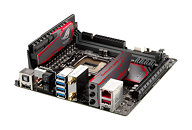
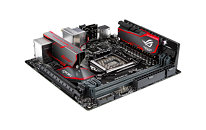
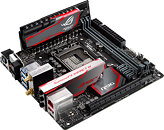
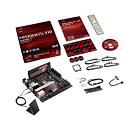
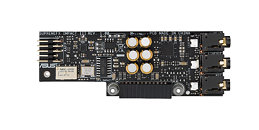

20 Comments on ASUS ROG Maximus VIII Impact Mini-ITX Motherboard Now Available
1) Where are at least 2 M.2 slots for RAID? Where is even single one?
2) WTF is one supposed to do with U.2 when you didn't even give us U.2 => M.2 conversion cable/module/board/kit.
3) How high is this huge vertical board on the opposide side of the PCIe slot? Will it block all cool huge tower air-coolers? Like Noctua NH-D15, D15S and D14 coolers or is it not that high?
4) where are analog out for
5.1/7.1 sound? edit: seems you can use the existing line-in and microphone jacks for 5.1 if you want.1) Where are at least 2 M.2 slots for RAID? Where is even single one? <- I am not sure, but my guess is their M.2 implementation is not very good. On their Asus H97I-PLUS board, they had M.2 slot, but you could not boot from the drive. Basically it was a very expensive storage solution. I think that still plagues them, so may be better off with no solution, than broken solution. Although it really is a bugger.
2) WTF is one supposed to do with U.2 when you didn't even give us U.2 => M.2 conversion cable/module/board/kit. <- they will probably throw some add-on or something or may be not?
3) How high is this huge vertical board on the opposide side of the PCIe slot? Will it block all cool huge tower air-coolers? Like Noctua NH-D15, D15S and D14 coolers or is it not that high? <- this doesn't personally bother me. "Huge air-coolers" doesn't exactly fit into all mITX cases, so not a con for me.
tpucdn.com/img/15-10-12/31a.jpg
it would make my wallet thin :D:D:D
1) I personally would prefer an M.2 slot over the U.2 connector that they included but looking at the layout of the board I'm not sure where they could even fit an M.2 slot, let alone 2 of them for RAID. They might have fit one M.2 on a daughter board if they removed the Alpine Ridge controller and USB 3.1 but I think they made the right call and chose U.2 and USB 3.1 Type C. Some other motherboards have mSATA or M.2 slots on the backside of the PCB but that may not have been practical given the added complexity of routing that many traces and the price point that they target with these boards.
2) A U.2 to M.2 adapter could certainly work to connect an M.2 drive but it will need a long cable to allow you to mount the M.2 drive elsewhere in your case. There just isn't enough space to put an M.2 drive anywhere on the front of the board. The CPU socket is too close to use a riser card where the U.2 slot is.
3) The NH-D14 and NH-D15 haven't had any clearance issues on ASUS's previous mITX Impact boards. The same should apply here unless they changed the height of the daughter boards or the location of the CPU socket (neither of which appear to have happened).
4) There is no analog out for 5.1 or 7.1 on this board. There just isn't enough space on the I/O section given everything else they chose to put there. MSI's mITX boards have included full 7.1 analog output in the past so that may be a better board if you need 5.1/7.1 analog output right from the motherboard.
2) you are supposed to use a u.2 drive with it.
3) same height as in the previous impact boards. large air coolers are still able to fit.
4) gaming itx boards are made for portable gaming in mind. you aren't going to be bringing your 7.1 setup to a LAN so it's not a priority.
This small board have everything. Only no SATA Express but that's not even important and that would be funny to ask.
Sound Card almost as dedicate, Bluetooth V 4.1, U.2 up to 32Gb/s, USB 3.1 A+C, even power section almost as on bigger boards.
Some other Mini ITX board have nothing of this 5 functions, very important. Without good onboard sound card Mini ITX boards are useless.
But Maximus VIII Gene is my favorite Z170 board. There you can use all advantage of powerful Chipset Gen 3.
One GPU, one M.2, Dedicate Sound, PCI-E SSD Gen 3 and USB 3.1 and you don't need nothing more for future, everything fit on Gene.
Compare please power section on ASUS Impact VIII and EVGA Z170 Stinger...
Impact easy hold i7-6700K with watercooling on 5.0GHz...
ASUS Impact VIII - EVGA Z170 Stinger
Bluetooth - No
USB 3.1 A+C - No
Wi-Fi - No
8 Phases - 4
U.2 - No
Supreme FX III - HD Audio
Mem 4133 OC - 3200+
SATA III x6 - x4
PRICE DIFFERENCE IN EUROPE 5e.
Looking Specification I would say someone compare some Rampage Extreme with AMD board.
This board CRY FOR ASUS R9 NANO. Special if someone use for HTPC where picture sharpness is more important than PhysX and 3D...Or ASUS Fury X with EKWB waterblock as single slot card.
I have a feeling that ASUS, Intel, and others know that U.2 is going to be the standard going forward for PCIe NVMe drives in desktops. U.2 is essentially M.2 over a cable rather than directly on the motherboard. It makes much more sense to have a cable and keep the drives in a 2.5" or 3.5" form factor elsewhere in the case. M.2 is perfect for laptops, tablets, and all-in-ones but mounting storage devices directly on the motherboard doesn't make sense for the desktop form factor, especially when users want multiple storage devices and board space is at a premium.
Because you can't everything on Mini ITX board. If you want everything than at least mATX board.
Impact is better board than MSI, have better power section, better Sound Card and that two things are important for such board.
Off course and better BIOS and memory compatibility as always, better package and if someone want SM951 but don't want Intel 750 SSD than I have no words really.
Intel 750 Gen 3 SSD is one best device now on market.
EKWB made waterblock for PCI-E version. Samsung SM951 will fire motherboard from back side with 2mm space between tray and motherboard.
But I believe that most users will keep 1-2 SSD 480GB on these type of motherboards.
Only ASUS increase this year price for Impact, in my country last years Impact didn't pass 180e.
But Hero enter on Maximus Formula place, Ranger enter on Hero place.
They should launch Ranger for 150e, Gene and Impact for 200, Hero for 250e and Extreme as most expensive.
Now I think price of Impact is higher than board worth. But if some Z170 Stinger, one empty motherboard cost 250e in Europe like we are fools than Impact worth 350e.
From one side I understand more and more people ask smaller motherboard and we have one absurd where less material, less DIMM slots, less PCI-E slots, cost more, Impact is more expensive than Gene.
I hope ASUS will launch Rampage 7 Gene with X190.
Also on case of M.2 you can put any other slower speed modules there that cost even less (about same as the SATA ssd-s) and the option to swap it out for high speed later when their prices drop maybe.Limited usage sound card is not better. Stereo is not good enough. Will not start using headphones ffs. Also buying entire new audio system that could use the optical out sounds a bit nonsense right now. Yes, it's possible, same as with using Intel 750.... but it's stupid and not needed requirement. Although.... maybe it might be about time to finally upgrade my speakers.
That speed is almost as some cheaper M.2 devices. And I specially don't like these plastic antenna on MSI board.
ASUS have some nice stuff in package as fan controller extension and thermal sensors. It's good to install example from other side of board behind CPU socket.
But anyway ASUS have best sensors and without that.
This sound card on Impact could compare with some of 60-70$ worth dedicate sound cards.
Maybe even improved. It's not as SBZ or Phoebus but far better than other solutions.
I was shocked with gaming effects on Supreme 2014 on my board, very strong effects and from rear speakers as default but these sound card use more space and probably is even better because we could install dedicate and on Mini ITX it's not possible because of that they paid attention on good sound.